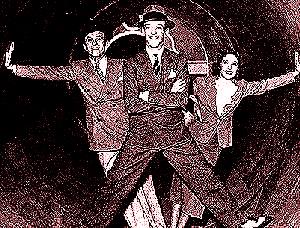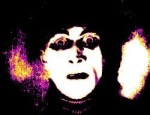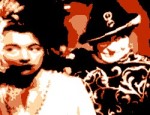Film Review

The film is significant in that Astaire appears without a dancing partner of equal stature, which may have been a conscious choice by the actor/dancer to prove to an audience that he could carry a film on his own, without someone as talented and glamorous as Ginger Rogers to support him. Cast in place of Rogers was the 18-year-old Joan Fontaine, an inexperienced actress who had no singing or dancing experience to speak of but no shortage of charisma. Early on in the production, Astaire became so frustrated with Fontaine's lack of promise as a dancer that he mooted replacing her with Ruby Keeler. Instead, Fontaine was retained but she was required to dance in just one dance number (Things Are Looking Up, one of the most charming numbers in the film), with some ingenious choreography and camerawork skilfully hiding her shortcomings as a dancer. The film's other big dance numbers were performed by Astaire, Burns and Allen, with Allen demonstrating surprising flair as a dancer.
The centrepiece of the film is a lavish song-and-dance sequence (Stiff Upper Lip) set in an Art Deco-styled fun house. Not only does this sequence test the skills of the three lead performers to the limit as they negotiate a veritable obstacle course of funfair attractions, but it proved to be just as challenging for the camera operators who somehow ensure that the whole sequence flows effortlessly, despite the complexity and confined nature of the set. The film's other great musical number is A Foggy Day, a hauntingly beautiful ballad sung by Astaire in a fog-wreathed woodland setting. Tragically, this was to be one of George Gerswhin's final compositions - he died before the film was completed from a brain tumour, aged 38.
A Damsel in Distress is far from being Fred Astaire's greatest film - if only Ginger Rogers were in it it would be perfect - but it has considerable charm and, bolstered by a combination of Wodehouse's comic verve and the Gershwins' musical genius, it has stood the test of time better than most musical comedies of this era. The film was not a success when it was first released - in fact it was the first of Astaire's films to lose money. Today, it holds up remarkably well and is one of Fred Astaire's more entertaining films - the comedy is superior to that of his more successful musicals, and the song-and-dance numbers are not too bad either. Not quite a classic, but an enjoyable romp all the same.
© James Travers 2012
The above content is owned by frenchfilms.org and must not be copied.
Film Synopsis
Everyone at Tottleigh Castle knows that Lady Alyce Marshmorton is about to get married, but no one knows for certain who the lucky man will be. When the servants hold a wager, houseboy Albert bets that Lady Alyce will take as her husband a complete stranger, whilst the butler Keggs is confident that she will select her mother's favourite, a jazz-loving buffoon named Reggie. When it is discovered that Lady Alyce has gone to London for a secret assignation with a young American, Keggs is sent to retrieve her before the family name is besmirched. In her attempt to avoid Keggs, Lady Alyce runs into Jerry Halliday, a famous American entertainer who is doing his damnedest to avoid his admirers. Determined to win his bet, Albert slips Jerry a fake love letter from Lady Alyce. Without a moment's hesitation, Jerry hastens to Tottleigh Castle, accompanied by his press agent George and the latter's scatterbrained secretary Gracie. Not knowing that Lady Alyce is in love with another man, Jerry begins to court her, egged on by Lord Marshmorton. The course of true love never did run smooth, but with Keggs and Albert stirring the love pot an increasingly frantic effort to win their bet anything appears possible. George may even end up marrying Gracie!© James Travers
The above content is owned by frenchfilms.org and must not be copied.
Similar Films
Here are some other films you may enjoy watching:- Give a Girl a Break (1953)
- Sous les toits de Paris (1930)
- Crustacés et coquillages (2005)
- Singin' in the Rain (1952)
- Modern Love (2008)
Other related links:
Film Credits
- Director: George Stevens
- Script: William J. Burns, P.J. Wolfson, P.G. Wodehouse (play), Ernest Pagano (play), S.K. Lauren (play), Ian Hay (play)
- Cinematographer: Joseph H. August
- Music: Robert Russell Bennett
- Cast: Fred Astaire (Jerry Halliday), George Burns (George), Gracie Allen (Gracie), Joan Fontaine (Lady Alyce Marshmorton), Reginald Gardiner (Keggs), Ray Noble (Reggie Byng), Constance Collier (Lady Caroline Marshmorton), Montagu Love (Lord John Marshmorton), Harry Watson (Albert), Jan Duggan (Miss Ruggles), Pearl Amatore (Madrigal Singer), May Beatty (Landlady), Charles Bennett (Carnival Barker), Frank Benson (Attendant), Angela Blue (Dancer), Ralph Brooks (Sightseer), James Clemens (Drunk), Mary Dean (Singer), James Fawcett (Drunk), Jack George (Madrigal Singer)
- Country: USA
- Language: English
- Support: Black and White
- Runtime: 98 min
The very best of German cinema

French cinema during the Nazi Occupation

The very best fantasy films in French cinema
